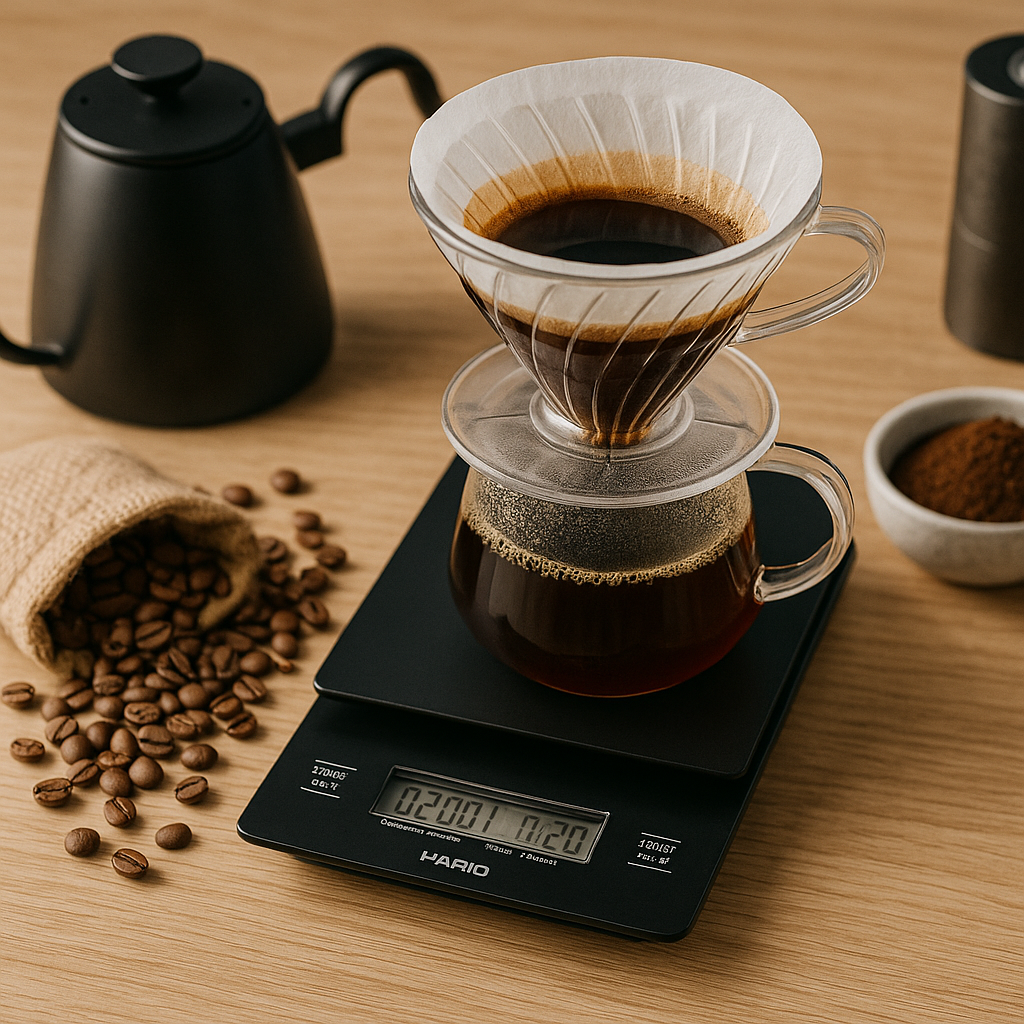For anyone getting serious about brewing coffee at home — whether with a French press, pour-over, AeroPress, or espresso machine — a coffee scale might seem like a minor accessory.
But ask any experienced barista, and they’ll tell you it’s one of the most important tools for consistent, great-tasting coffee.
In this beginner’s guide, we’ll explore why a coffee scale matters, what features to look for, and we’ll highlight some of the best budget-friendly options available in 2025.
Why Use a Coffee Scale?
If you’re used to scooping your coffee by eye or using a tablespoon, you might wonder: why switch to weighing it?
The short answer: precision equals consistency. Brewing coffee is a chemical process. Tiny changes in the coffee-to-water ratio can lead to dramatic differences in flavor — sometimes bitter, sometimes sour, sometimes perfect.
Here’s why a scale makes all the difference:
Accuracy in Ratios
Using a scale ensures you’re brewing with the ideal ratio of coffee to water. Most pour-over methods use 1 gram of coffee for every 15–18 grams of water.
Consistent Flavor
Once you find the sweet spot for your preferred brewing method, a scale helps you repeat that experience every time, regardless of bean density or grind size.
Espresso Calibration
Espresso requires precise inputs: usually around 18–20g of coffee for a double shot. A digital scale helps dial in doses and measure yield accurately.
Avoids Waste
By measuring exactly what you need, you reduce wasted beans and water — good for your wallet and the environment.
Professional Results at Home
Baristas rely on scales for competition-level coffee. With one, you instantly elevate your brewing technique.
Key Features to Look for in a Coffee Scale
Not all scales are created equal. Some are great for baking, but they don’t offer the features you need for coffee. Here’s what to prioritize:
1. Precision
The scale should measure in grams, ideally down to 0.1 grams. This level of accuracy is crucial for both espresso and manual brewing.
2. Speed
A good coffee scale reacts instantly. A slow display can cause over-pouring or inconsistent results, especially during a timed pour-over.
3. Built-In Timer
Many coffee scales now come with a built-in timer, allowing you to track bloom and total brew time — essential for methods like V60 or Chemex.
4. Waterproof or Spill-Resistant Surface
Spills are inevitable. Choose a scale that’s water-resistant or has a sealed surface to prevent damage from coffee or water.
5. Compact Design
Make sure the scale fits under your espresso machine or on your brewing station. Look for slim, low-profile designs.
6. Auto-Off Control
Some cheaper scales turn off after 60 seconds — not ideal mid-brew. Many modern coffee-specific models offer adjustable or no auto-off.
7. Rechargeable Battery or USB Charging
Models with USB charging are more convenient than those requiring AAA batteries. Rechargeable batteries also reduce waste over time.
Best Coffee Scales for Beginners in 2025
Let’s take a look at some of the top-rated, beginner-friendly coffee scales available this year. These options balance price, performance, and durability.
1. Hario V60 Drip Scale
Price: ~$50
Best for: Pour-over enthusiasts
Hario’s V60 scale is a favorite in specialty coffee shops. It features both a precision scale and a built-in timer — ideal for mastering your bloom, pulse pours, and total brew time.
Pros:
- Designed specifically for coffee
- Accurate to 0.1g
- Timer included
- Sleek design
Cons:
- Slight delay in weight update
- Not waterproof
- Battery operated (2 AAA)
Why it’s great:
Perfect for those focusing on pour-over methods like V60, Chemex, or Kalita Wave.
2. Timemore Black Mirror Basic+
Price: ~$65
Best for: Espresso and pour-over versatility
Timemore’s Black Mirror Basic+ combines sleek aesthetics with high-level performance. Its fast response time and matte finish make it ideal for brewing and pulling shots.
Pros:
- Accurate to 0.1g
- Fast refresh rate
- Touch buttons
- Rechargeable via USB-C
Cons:
- No waterproof seal (though spill-resistant)
- More expensive than entry-level models
Why it’s great:
A beautiful, reliable choice for coffee lovers who want accuracy and style in one.
3. Greater Goods Digital Coffee Scale
Price: ~$39
Best for: Budget-conscious brewers
This scale offers high precision at a wallet-friendly price. Though it doesn’t have all the fancy features, it provides accurate measurements and a decent timer — enough for most brewing needs.
Pros:
- Budget-friendly
- Measures to 0.1g
- Simple timer
- Compact and easy to store
Cons:
- No USB charging
- Plastic build
- Timer isn’t as responsive
Why it’s great:
Ideal for beginners looking to improve their brew without breaking the bank.
4. Acaia Lunar (High-End Option)
Price: ~$250
Best for: Espresso enthusiasts and professionals
While it’s more expensive than most beginner options, the Acaia Lunar is worth mentioning. It’s the gold standard for espresso scales — ultra-fast, water-resistant, and app-connected.
Pros:
- Ultra-precise and fast
- Fully waterproof
- Rechargeable battery
- Bluetooth connectivity with brewing apps
Cons:
- Price
- Overkill for casual brewers
Why it’s great:
If you’re serious about espresso or plan to upgrade over time, it’s a scale that will last for years.
5. OXO Brew Precision Scale
Price: ~$54
Best for: Multi-purpose use (coffee and kitchen)
OXO’s precision scale is larger than most coffee-specific models, but it works well for pour-over or French press brewing, and even for weighing beans for storage.
Pros:
- Large platform
- Easy-to-read display
- Accurate to 0.1g
- Auto-off delay setting
Cons:
- Too bulky for espresso machines
- No built-in timer
Why it’s great:
Perfect for home brewers who also enjoy baking or other kitchen tasks, but want a reliable coffee tool.
How to Use a Coffee Scale: Step-by-Step
Here’s a simple guide to help you get started with your new scale.
Step 1: Turn It On and Tare
Place your brewing vessel or portafilter on the scale, then press the tare button to reset the display to zero.
Step 2: Add Coffee Grounds
Add your ground coffee. Most recipes call for around 15–20 grams for pour-over, or 18–20 grams for a double espresso.
Step 3: Tare Again
If you’re using pour-over or immersion methods, tare again after adding the coffee so the next reading reflects the water only.
Step 4: Start Your Timer
Begin pouring water and start the timer simultaneously. This helps track bloom time and total brew time.
Step 5: Watch the Numbers
Use the scale to monitor how much water you’re adding — whether it’s 240g, 300g, or more depending on your recipe.
Step 6: Practice and Adjust
Once you’ve brewed, taste your coffee and take notes. Adjust the dose or water next time for improvement.
FAQs About Coffee Scales
Q: Can I use a kitchen scale for coffee?
A: Technically, yes — but most kitchen scales don’t measure to 0.1g and may have delays or auto-off features that make coffee brewing frustrating.
Q: Do I need a scale for espresso only?
A: It’s useful for every method. From AeroPress to Chemex, precise measurements help you brew consistent, delicious coffee.
Q: How long do digital coffee scales last?
A: With proper care and avoiding water damage, a good scale can last 3–5 years or more. Higher-end models may last even longer.
Q: What’s the ideal coffee-to-water ratio?
A: For pour-over and drip, a common starting point is 1:16 (e.g., 20g coffee to 320g water). Espresso uses around 1:2 (e.g., 18g in, 36g out).
Q: Do I need a timer if I already use my phone?
A: You can use your phone, but an integrated timer streamlines the process and minimizes distractions.
Final Thoughts: Invest in Precision, Brew with Confidence
If you’re ready to take your home coffee brewing to the next level, a quality scale is one of the smartest, most affordable upgrades you can make. It brings consistency, control, and confidence to your process — whether you’re just beginning or already experimenting with grind size and brew time.
Choose a scale that fits your method, budget, and brewing style. Whether it’s a simple option like the Greater Goods scale or a sleek Timemore model, the right tool will transform your daily ritual from guesswork to greatness.

